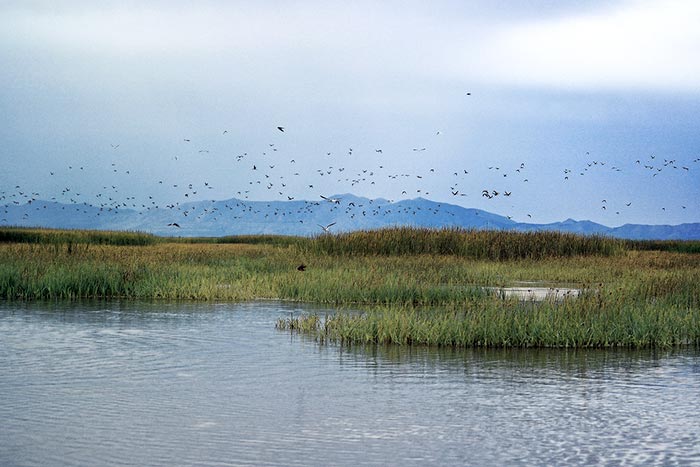Metal mayhem …

Plants in Great Salt Lake wetland ecosystems are able to pull hazardous metal pollution from the lake and sometimes pass it up the food chain, according to new research from Utah State University.
Credit: USFWS Mountain-Prairie / Usage Restrictions: Photo for use with this research announcement only.
New research finds toxic metals absorbed by Great Salt Lake plants and insects.
Plants in Great Salt Lake wetland ecosystems are able to pull hazardous metal pollution from the lake and sometimes pass it up the food chain, according to work by a team of researchers from the Department of Watershed Sciences led by Edd Hammill. The study, coauthored by former master’s student Maya Pendleton and current faculty Janice Brahney, Karin Kettenring, and Trisha Atwood, sampled three types of native plants (threesquare, hardstem, and alkali bulrush) and invasive phragmites to monitor concentrations of metals and see where in the plants they accumulated.
Toxic metals reach the Great Salt Lake predominantly by way of runoff and atmospheric pollution from human industry, such as mines and refineries. Wetland plants absorb metals from the soil and store them belowground (in roots, bulbs, and rhizomes) or aboveground (in shoots, leaves, and seeds). Where in the plant these metals end up residing has implications for environmental health, according to the research.
“All the plants sampled were adept at storing selenium and arsenic belowground,” said Hammill. “However, the phragmites had the highest concentrations of lead and mercury in their seeds, and all the plants had significant concentrations of other metals in their aboveground tissues.”
Toxic metals in aboveground plant tissues are a cause for concern for the insects that eat them and the terrestrial food web as whole, the researchers said.
“The metals are fat soluble,” said Hammill, “so every bit consumed by herbivorous insects is stored in the insect tissues and gets passed on to predatory insects like spiders, damselflies, and dragon flies. Larger predators consume the predatory insects and the toxic metals move right up the food chain in larger concentrations.”
The research found copper and cadmium levels ten times higher in predatory insects than in wetland plants, a hazard to resident waterfowl and the large numbers of migratory birds who flock to Great Salt Lake wetlands and feed on insects before passing on to other far-off habitats. In future studies, the team hopes to take a closer look at toxic metal concentrations in Great Salt Lake waterfowl, which are under consumption advisories.
The propensity for wetland plants to absorb hazardous metals could be useful as a way to clean up lake pollution, said Hammill. To remove or decrease toxic metal pollution should be the ultimate goal, but considering this study, leaving wetland root systems intact while cutting the aboveground foliage and burying it in low-impact locations would be a practice worthy of consideration by management agencies, he said.
The negative impact of metals in plants and animals ties into the broader conversation about conservation of the Great Salt Lake, particularly when it comes to lake water levels which have declined to record lows.
“Keeping the Great Salt Lake watered is critical to making sure the metals stay where they are now,” said Hammill. “If the lakebed gets exposed, dust and metals become airborne, which has a considerable human impact and makes the whole problem worse.”
Journal: Ecotoxicology
DOI: 10.1007/s10646-022-02550-6
Method of Research: Experimental study
Subject of Research: Not applicable
Article Title: Metal concentrations in wetland plant tissues influences transfer to terrestrial food webs
Article Publication Date: 6-May-2022
Media Contact
All latest news from the category: Ecology, The Environment and Conservation
This complex theme deals primarily with interactions between organisms and the environmental factors that impact them, but to a greater extent between individual inanimate environmental factors.
innovations-report offers informative reports and articles on topics such as climate protection, landscape conservation, ecological systems, wildlife and nature parks and ecosystem efficiency and balance.
Newest articles

Octopus inspires new suction mechanism for robots
A new robotic suction cup which can grasp rough, curved and heavy stone, has been developed by scientists at the University of Bristol. The team, based at Bristol Robotics Laboratory,…

Peptides on Interstellar Ice
A research team led by Dr Serge Krasnokutski from the Astrophysics Laboratory at the Max Planck Institute for Astronomy at the University of Jena had already demonstrated that simple peptides…

A new look at the consequences of light pollution
GAME 2024 begins its experiments in eight countries. Can artificial light at night harm marine algae and impair their important functions for coastal ecosystems? This year’s project of the training…





















